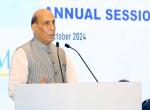India has taken a substantial step forward in acquiring a credible nuclear deterrent capability with its successful Agni V test on April 19. The security threats to India are almost unique in that we have two nuclear neighbours who have had military conflicts with us in the past, who even now lay claims to our territory, whose seek to corner us strategically and who have long colluded in nuclear and missile matters.
Despite the acuteness of our security challenges our response has lacked a sense of urgency. While aware of their source and nature, we have not been able to make up our minds on the size and scope of our response and the manpower and funds to be allocated to develop the technologies and capacities to meet these threats.
Approach
We have tended to discount any large scale military threat from either adversary. We have felt confident about coping with any Pakistani military adventurism with the strength we possess. In China’s case, our assessment has been that with the existing border agreements on peace and tranquillity and sundry CBMs that reflect the desire of both countries to avoid military tensions on the border, coupled with political level efforts to set up a mechanism for border negotiations, the danger from China was more long term than immediate. China, in our thinking, would also want to preserve the myth of its peaceful rise and would therefore avoid an unnecessary military conflict with us, particularly as India poses no military threat to its control over Tibet.
We have also been able to dodge taking hard national security decisions by avoiding a military response to Pakistani provocations and a robust poitical response to those from China. We have not allowed tensions to escalate, preferring dialogue and engagement instead. If Pakistan does a Mumbai our answer is dialogue; if China questions our sovereignty over Arunachal Pradesh or Kashmir, far from picking up the challenge, we look for a compromise formula to resume military contacts and gratuitously bolster the image of Sinkiang’s political head by inviting him to India despite the public upheavel there against Chinese rule. Even as we are concerned about Chinese strategic inroads into the Indian Ocean, we endorse maritime cooperation with them in these waters.
Thus, we reinforce our proclivity not to take hard decisions by making believe that our security dilemmas can be managed through diplomatic engagement rather than accelerating our strategic military programmes. In reality, while self-restraint and attachment to peace mark do our policies, we choose soft options also because we are conscious of our weakness and lack of military preparedness.
Comparison
The Agni V test needs to be seen in this broad context. Our Integrated Missile Development Programme began in 1983 but it is only now that we have successfully tested a real strategic delivery capability. Compared to China, our progress has been slow, either because of technical hurdles or inadequate committment of resources to the task. If the Chinese needed to develop capabilities to counter the exercise of US power in their neighbourhood, we needed to counter the exercise of combined Chinese and Pakistani power against us, without entering into an arms race with China just as the latter has not entered into one with the US.
The delay in developing our strategic delivery capability compounds our political difficulties. China is now a mature missile power with ICBM capability. Its new ballistic missile capable of hitting US naval assets at a long distance has attracted attention, but otherwise the upgradation of its long range missiles proceeds quietly. Russia too is developing a powerful new missile but this too hardly makes news. India’s missile programme will take some more years to mature and will therefore continue to be in the public eye, making India, that wants to project the image of a peaceful and responsible power, look like pursuing threatening and regionally destabilizing capabilities of the kind North Korea and Iran are accused of. We have repeated the mistake we made in acquiring nuclear capability much later than we could and should have.
Response
While the China dimension of Agni V will not escape expert commentary, the way our media has played this up reflects our immaturity as a society in handling sensitive strategic matters. If the Chinese media were to graphically report how Chinese missile deployments in Tibet are intended to bring major north Indian cities into their destructive range, the outcry in India will be huge. Because of our lack of discretion we have provoked unnecessary polemics against us in the Chinese media, though the Chinese government, to its credit, has reacted with maturity.
In actual fact Agni V should have caused no surprise to the Chinese as India has been transparent about its Agni missile programme and the planned range of 5000 kilometers. China, in any case, possesses missiles with even longer range. Earlier it was India that was vulnerable to Chinese missiles and now the reverse will be true, creating a better balance in deterrence.
US’s reaction to Agni V is noteworthy as it reflects the new quality of India-US bilateral relations even in areas that were highly problematic in the past. In the 90s and early 2000s, the US was pressing india to curb its missile programme because it was seen as destabilizing. Even ISRO had been sanctioned because of US missile-related concerns. The thinking today is entirely different. While avoiding any specific disapproval of India’s step, the US has lauded India’s non-proliferation credentials and underlined its no-first use policy, whch would suggest that India’s missile advance is actually seen as serving US interests too in creating a better Sino-Indian strategic balance in the years ahead.
Author is Member Advisory Board at Vivekananda International Foundation and Former Foreign Secretary
Published in Mail Today 24th April 2012









Post new comment